Front-end developers are the architects of the digital world, crafting the visual and interactive elements that users engage with. They are responsible for translating design concepts into functional code, ensuring that websites and applications are not only visually appealing but also intuitive and responsive across various devices.
To excel in front-end development, one must master core web technologies such as HTML, CSS, and JavaScript. Additionally, skills like problem-solving, attention to detail, and effective communication are crucial for collaborating with designers and back-end developers to create cohesive digital experiences.
Candidates can write these abilities in their resumes, but you can’t verify them without on-the-job Front-End Developer skill tests.
In this post, we will explore 8 essential Front-End Developer skills, 8 secondary skills and how to assess them so you can make informed hiring decisions.
Table of contents
8 fundamental Front-End Developer skills and traits
The best skills for Front-End Developers include HTML/CSS, JavaScript, Responsive Design, Version Control, Cross-Browser Compatibility, Web Performance Optimization, JavaScript Frameworks and Testing/Debugging.
Let’s dive into the details by examining the 8 essential skills of a Front-End Developer.
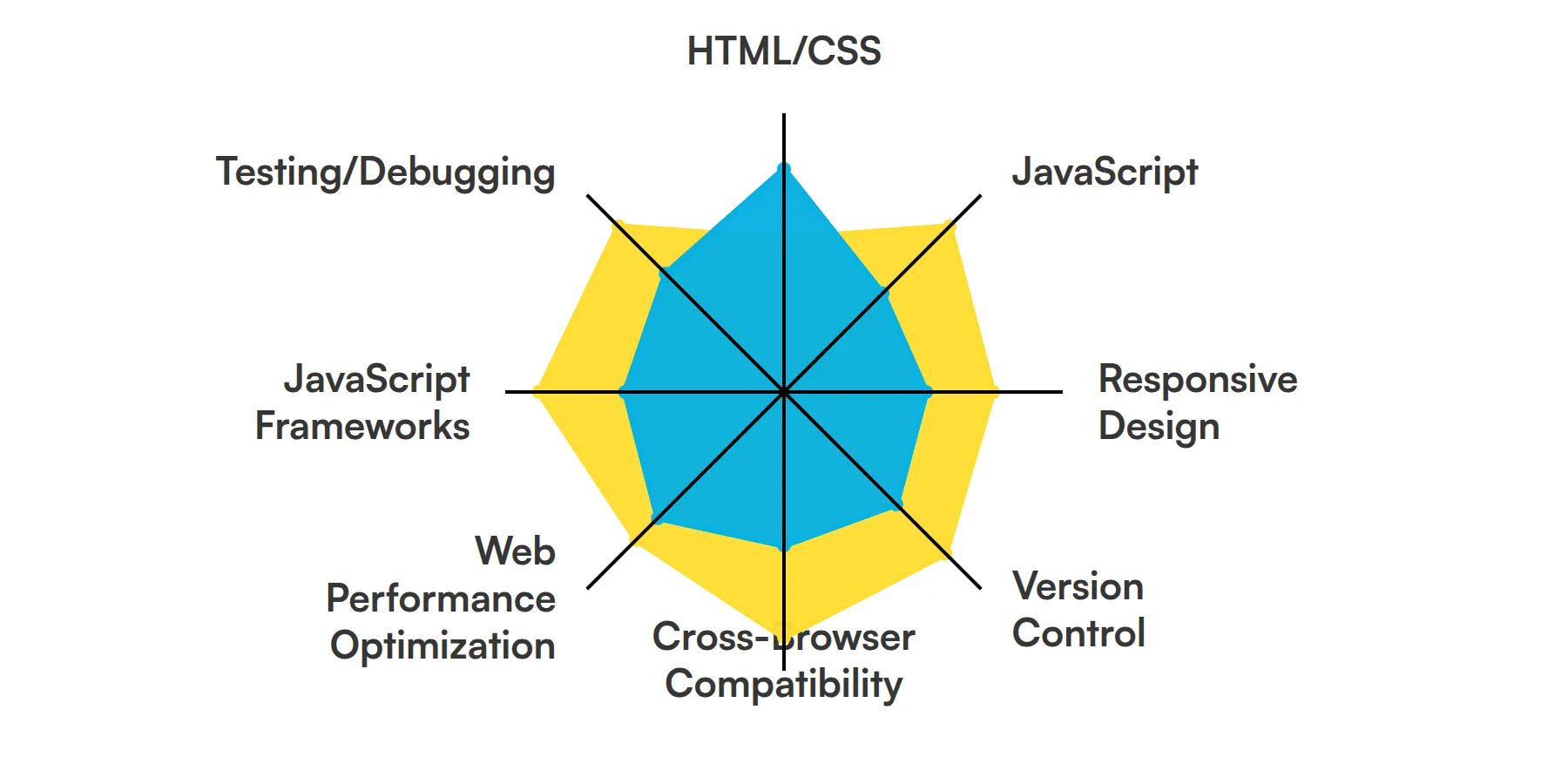
HTML/CSS
HTML and CSS form the backbone of web development. A front-end developer uses HTML to structure content and CSS to style it, ensuring that web pages are both visually appealing and accessible across different devices and browsers.
For more insights, check out our guide to writing a HTML5 Developer Job Description.
JavaScript
JavaScript is the programming language that brings interactivity to web pages. Front-end developers use it to create dynamic content, handle events, and build complex user interfaces, making websites more engaging and functional.
Responsive Design
With the variety of devices available today, responsive design is crucial. Front-end developers must ensure that websites look and function well on desktops, tablets, and smartphones, providing a seamless user experience regardless of screen size.
Check out our guide for a comprehensive list of interview questions.
Version Control
Version control systems like Git allow developers to track changes in their codebase, collaborate with others, and manage different versions of a project. This skill is essential for maintaining code integrity and facilitating teamwork.
Cross-Browser Compatibility
Websites need to function correctly across different browsers. Front-end developers must test and optimize their code to ensure consistent performance and appearance, addressing any quirks specific to each browser.
For more insights, check out our guide to writing a Web Developer Job Description.
Web Performance Optimization
Optimizing web performance involves reducing load times and improving the speed of a website. Front-end developers achieve this by minimizing file sizes, optimizing images, and leveraging caching strategies to enhance user experience.
JavaScript Frameworks
Frameworks like React, Angular, or Vue.js help developers build complex applications more efficiently. They provide pre-built components and tools that streamline the development process, allowing front-end developers to focus on creating rich user interfaces.
Check out our guide for a comprehensive list of interview questions.
Testing/Debugging
Testing and debugging are critical to ensuring that web applications function as intended. Front-end developers use tools and techniques to identify and fix issues, ensuring a smooth and error-free user experience.
8 secondary Front-End Developer skills and traits
The best skills for Front-End Developers include CSS Preprocessors, Command Line, RESTful APIs, Web Accessibility, Graphic Design Tools, SEO Principles, Build Tools and TypeScript.
Let’s dive into the details by examining the 8 secondary skills of a Front-End Developer.
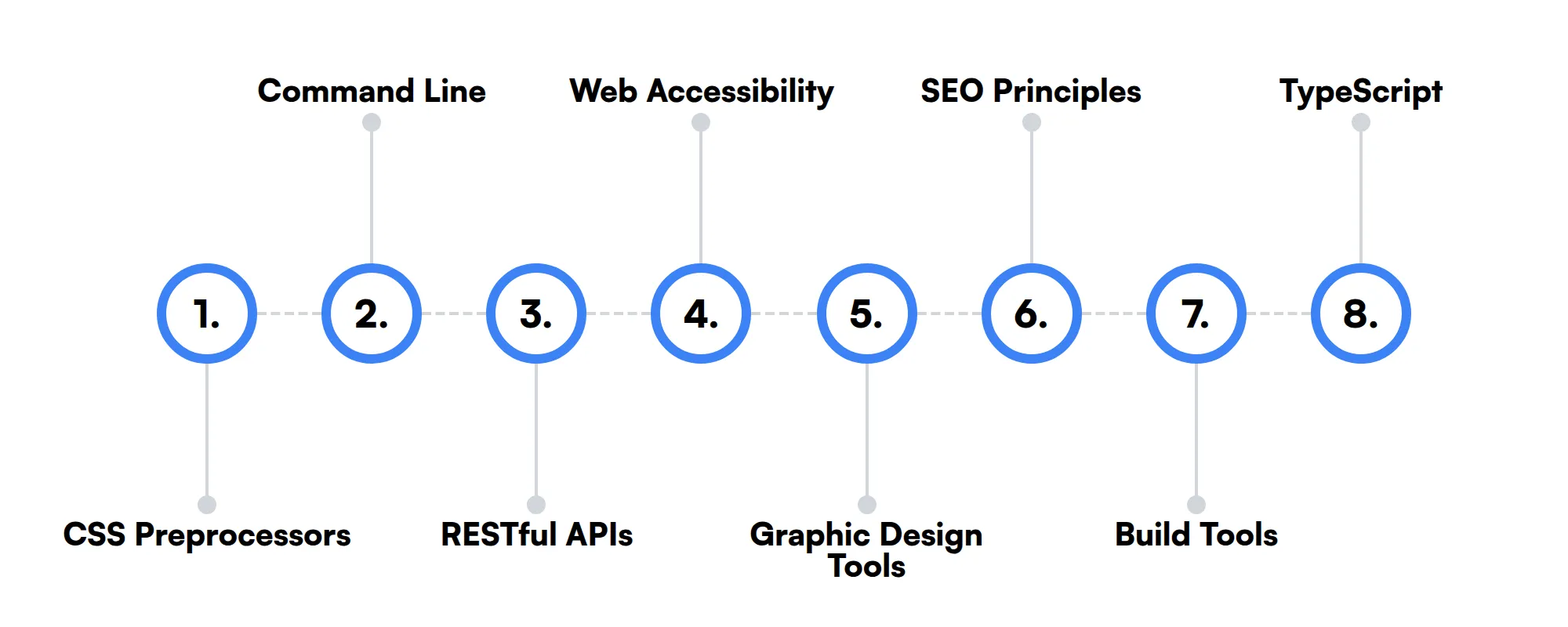
CSS Preprocessors
CSS preprocessors like SASS or LESS extend CSS with variables, nesting, and functions, making stylesheets more maintainable and scalable for front-end developers.
Command Line
Basic command line skills help developers navigate file systems, run scripts, and manage development environments more efficiently, streamlining their workflow.
RESTful APIs
Understanding RESTful APIs is important for integrating front-end applications with back-end services, allowing developers to fetch and display data dynamically.
Web Accessibility
Web accessibility ensures that websites are usable by people with disabilities. Front-end developers implement best practices to make web content accessible to all users.
Graphic Design Tools
Familiarity with graphic design tools like Adobe Photoshop or Sketch can help front-end developers create and edit visual elements, enhancing the overall design of a website.
SEO Principles
Understanding SEO principles helps front-end developers optimize web pages for search engines, improving visibility and driving more traffic to the site.
Build Tools
Build tools like Webpack or Gulp automate tasks such as minification and bundling, helping front-end developers streamline their development process and improve efficiency.
TypeScript
TypeScript is a superset of JavaScript that adds static types, helping developers catch errors early and write more robust code, especially in large projects.
How to assess Front-End Developer skills and traits
Assessing the skills of a Front-End Developer involves more than just glancing at their resume. It's about understanding how well they can use their technical skills to create seamless, user-friendly websites. A resume might show you what they know, but not how well they use it in real-world scenarios.
To truly assess these skills, you need a method that tests their abilities in HTML/CSS, JavaScript, and other essential front-end technologies. This is where practical assessments come into play. By using tests that mimic real-world tasks, you can see how candidates handle typical front-end challenges, from responsive design to web performance optimization.
One effective way to streamline this process is through Adaface assessments, which are designed to evaluate the core competencies of Front-End Developers. These assessments help you see beyond the resume, providing a clear picture of a candidate's ability to handle the demands of the role. With Adaface, companies have seen a 85% reduction in screening time, making it easier to find the right talent quickly.
Let’s look at how to assess Front-End Developer skills with these 5 talent assessments.
HTML/ CSS Online Test
Our HTML/ CSS Online Test evaluates a candidate's ability to design and style web pages effectively using HTML and CSS. This test is designed to measure proficiency in core web development skills such as creating responsive layouts and integrating multimedia content.
The test assesses their understanding of HTML forms, CSS box model, Flexbox, Grids, and media queries. It also evaluates their skills in applying CSS for styling and animations, and their ability to handle HTML DOM efficiently.
Successful candidates demonstrate a strong grasp of CSS styling techniques, responsive design principles, and the integration of modern web layout technologies.

JavaScript Online Test
Our JavaScript Online Test gauges a candidate's expertise in JavaScript, from basic programming constructs to advanced asynchronous and OOP concepts. This test includes scenarios that require manipulation of the HTML DOM and handling of APIs.
This test challenges candidates on JavaScript ES6 features, error handling, and JSON data manipulation. It also tests their ability to write asynchronous code using promises and async/await.
High-scoring candidates will show proficiency in both foundational JavaScript concepts and modern asynchronous programming techniques.
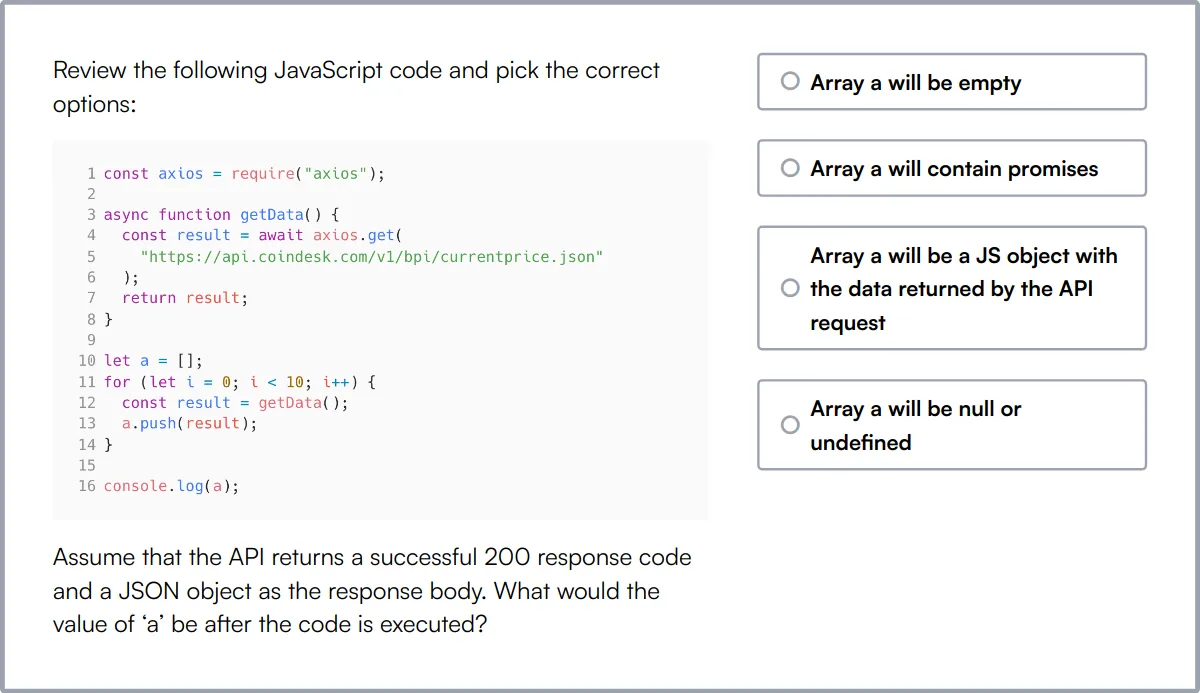
Git Online Test
Our Git Online Test assesses a candidate's knowledge and proficiency with Git, focusing on everything from basic commands to complex branching and merging strategies. This test is crucial for evaluating a developer's ability to manage code versions effectively.
The test evaluates understanding of Git fundamentals, conflict resolution, and use of remote repositories. It also covers advanced topics like rebasing and various Git workflows.
Candidates who perform well on this test demonstrate a solid command of source code management and the ability to resolve version control issues effectively.
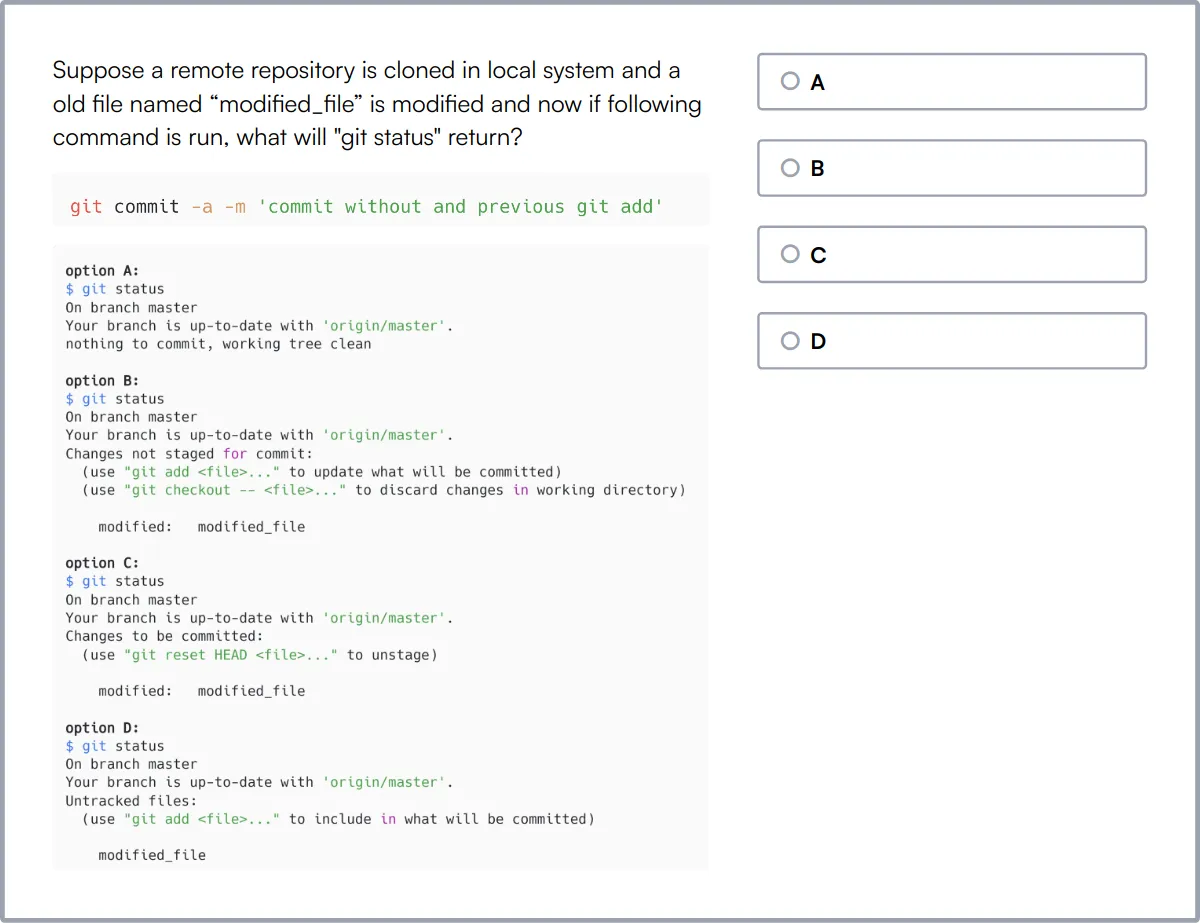
Vue.js Online Test
Our Vue.js Online Test evaluates a candidate's ability to develop dynamic web applications using Vue.js. This includes testing their skills in using Vuex for state management and Vue Router for navigation.
The test assesses candidates on Vue component design, DOM manipulation, and state management with Vuex. It also evaluates their skills in communicating with HTTP servers and implementing authentication.
Successful candidates will demonstrate a thorough understanding of Vue.js fundamentals, component architecture, and modern web application development practices.
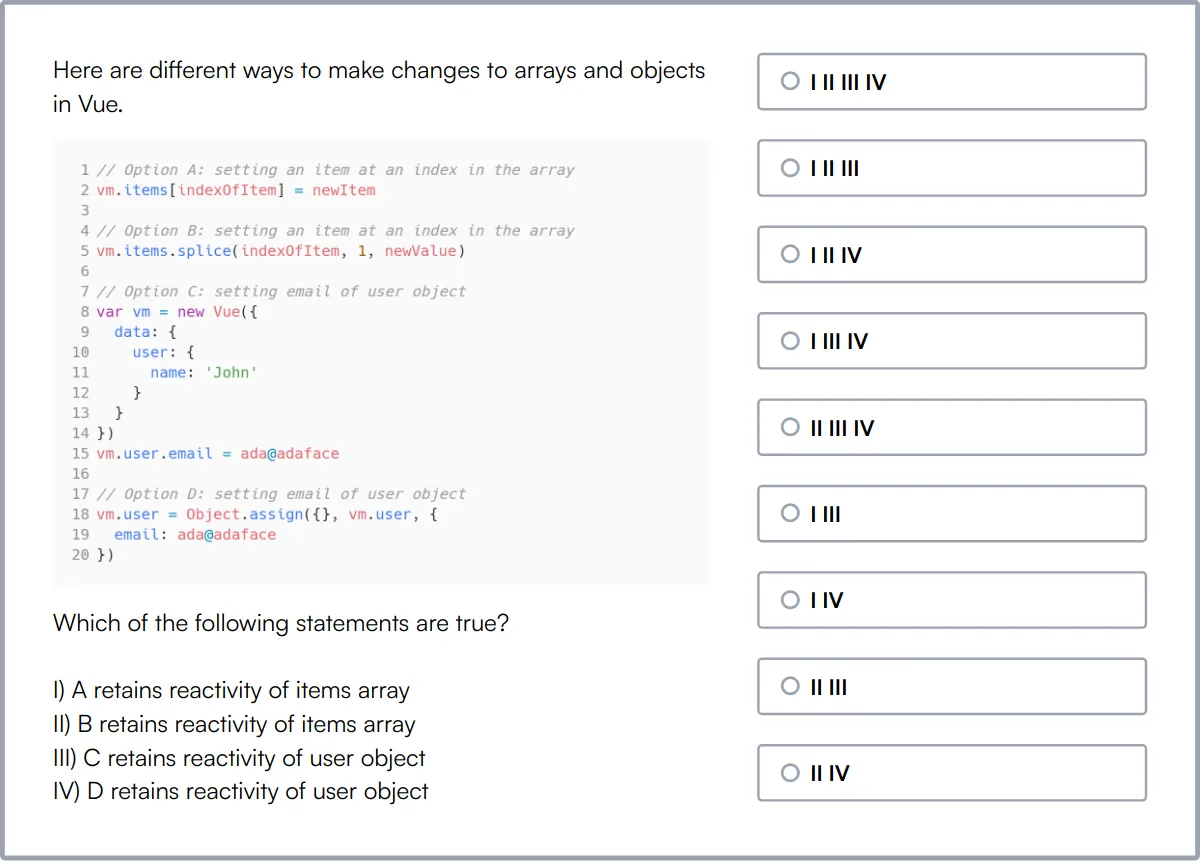
Jest Test
Our Jest Test measures a candidate's ability to use Jest for testing JavaScript applications, focusing on both unit and integration tests. This test is designed to evaluate proficiency in writing test cases and using Jest's advanced features for mocking and asynchronous testing.
The test covers Jest configuration, test-driven development, and the use of matchers and assertions. It also evaluates the candidate's ability to handle async testing and integration with other tools.
Candidates excelling in this test demonstrate strong testing skills, the ability to troubleshoot and debug tests, and maintain high-quality code standards.
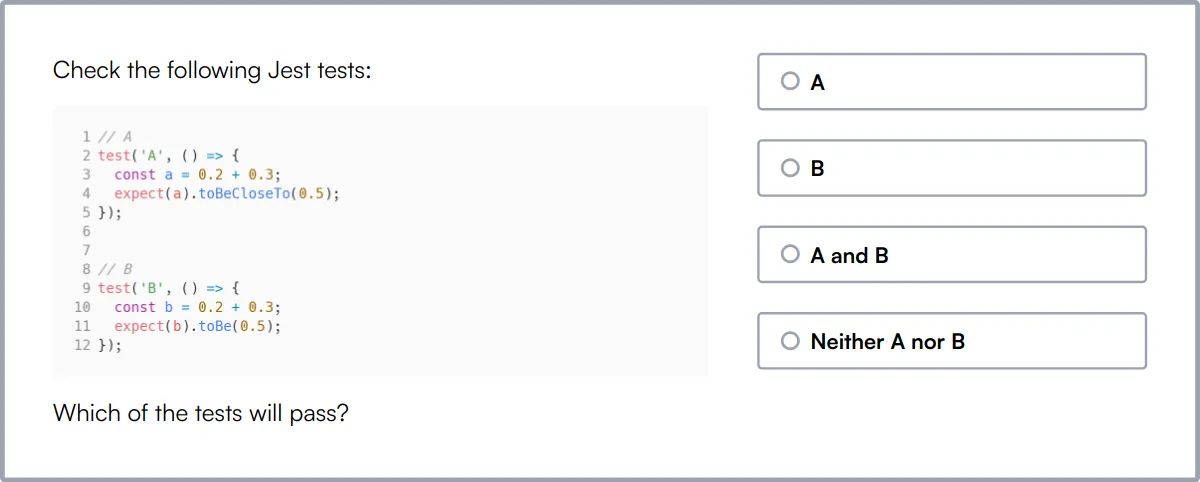
Summary: The 8 key Front-End Developer skills and how to test for them
| Front-End Developer skill | How to assess them |
|---|---|
| 1. HTML/CSS | Gauge how a developer creates a well-structured, user-friendly interface. |
| 2. JavaScript | Assess a developer’s skills in creating interactive, dynamic designs. |
| 3. Responsive Design | Determine a candidate’s skills in building flexible designs for devices. |
| 4. Version Control | Evaluate how a developer manages code changes and collaboration. |
| 5. Cross-Browser Compatibility | Check if designs function consistently across different web browsers. |
| 6. Web Performance Optimization | Assess ability to enhance website speed and performance. |
| 7. JavaScript Frameworks | Evaluate use of libraries and prebuilt components to ease work. |
| 8. Testing/Debugging | Decide if a candidate can locate and solve bugs and errors. |
Front End Developer Online Test
Front-End Developer skills FAQs
What are the key HTML/CSS skills a front-end developer should have?
Front-end developers should be proficient in writing semantic HTML, structuring web pages effectively, and designing visually appealing layouts with CSS. They should also be skilled in CSS frameworks like Bootstrap or Foundation.
How important is JavaScript for a front-end developer?
JavaScript is critical for front-end development as it enables interactive and dynamic user experiences on web pages. Developers should understand both vanilla JavaScript and popular frameworks like React or Angular.
What does responsive design entail and why is it important?
Responsive design ensures that web applications function well on a variety of devices and screen sizes. It involves using flexible layouts, images, and CSS media queries.
Why is version control important in front-end development?
Version control systems like Git help developers track and manage changes to the codebase, collaborate with others, and maintain a history of project modifications, which is invaluable for debugging and understanding project evolution.
What should a front-end developer know about web performance optimization?
Developers should focus on optimizing page load times by minimizing HTTP requests, optimizing file sizes (images, CSS, JavaScript), and utilizing techniques like lazy loading and content delivery networks (CDNs).
How can front-end developers ensure web accessibility?
Developers should adhere to WCAG guidelines, use semantic HTML, ensure keyboard navigability, and implement ARIA roles to make web content accessible to all users, including those with disabilities.
What role do CSS preprocessors play in front-end development?
CSS preprocessors like Sass or LESS allow developers to write code in a more modular, maintainable way with features like variables, nesting, and mixins, which are then compiled into standard CSS.
How does understanding SEO principles benefit a front-end developer?
Knowledge of SEO principles helps developers structure content effectively, ensuring websites are indexed correctly by search engines and perform well in search results, which is key for user visibility.

40 min skill tests.
No trick questions.
Accurate shortlisting.
We make it easy for you to find the best candidates in your pipeline with a 40 min skills test.
Try for freeRelated posts
Free resources



